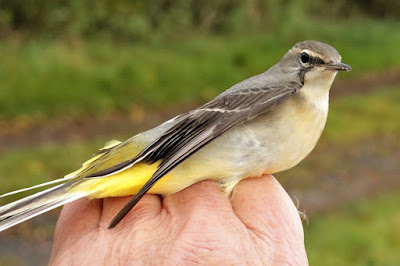We took advantage of Friday's clear but frosty morning with a six-thirty start to the ringing session. Will arrived on site at Pilling from an easterly direction and was lucky enough to see a Barn Owl cross the road in front of his car. By then Andy and I who arrived from the opposite direction were halfway down the access road and missed seeing the owl in our haste to get the nets going.
It was a shock to the system to discover that a number of the guy ropes we leave on for early speed were solid with a layer of ice. For the first time this autumn/winter we needed gloves to hand.
More than 20 Little Egrets left the tree roost when the car lights disturbed their sleep and we heard Redwings flying over. We didn’t catch Redwings or Little Egrets and at first it seemed that there weren’t too many birds around in the minus temperatures.
Things improved as intermittent sun arrived to give us a mixed bag of 21 birds of 8 species - 9 Greenfinch, 3 Linnet, 2 Reed Bunting, 2 Goldcrest, 2 Wren, 1 Chaffinch, 1 Blue Tit and 1 Cetti’s Warbler.
One of the first birds out was our second Cetti’s Warbler at this site, this latest a male, following the tiny female we caught on October 4th.
Males are larger than females and some can hold large territories with up to three females. Consequently, the UK population of around 3500 territories is now judged on the number of singing males present rather than “pairs” with the population as a whole thought to be resident rather than migratory.
The early morning sun enhanced the red/brown tints of the Cetti’s plumage.
Cetti's Warbler
Although the number of Linnets around was not huge today (70/90 birds) we caught a couple of obvious Scottish types. The first winter female below was especially striking through the dark mantle and its dusky and heavily streaked breast feathers, quite unlike the softer tones of local Linnets.
At last there seems to be Reed Buntings around and of the seven or eight we saw, two new ones was an improvement on recent numbers. We think that our provision of winter supplementary food for all will see more Reed Buntings in the weeks to come.
The Reed Bunting is one of the species that suffers from the "winter hunger gap". This is the time of year when winter is at its harshest and natural food like seeds, berries and insects are scarce or unavailable to farmland birds. Typically, it lasts from December until March.
This date in November might be a little late for migratory Goldcrests. It’s a species that is in short supply through the winter months where overnight frosts can quickly kill off a tiny bird that weighs less than six grams.
Perhaps these late Goldcrests are ones from northern Europe, like the similarly sized Pallas’s Leaf Warbler seen on Thursday just across the water in Fleetwood’s Mount Park? The Pallas’s had travelled over 3,000 miles from the mountain forests of southern Siberia, east to northern Mongolia and China.
Other birds seen today - Buzzard, Sparrowhawk, 2 Stonechat. Fifteen or twenty Meadow Pipits and several Skylarks.
The weekend beckons. Back soon with more news, views and photos on Another Bird Blog.
Linking this weekend to Eileen's Blogspot and Anni in Texas.




.JPG)








































.jpg)













